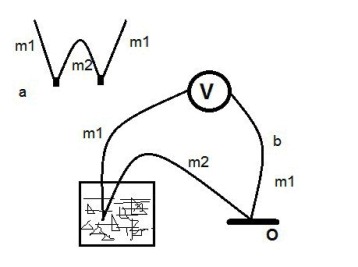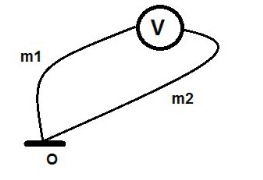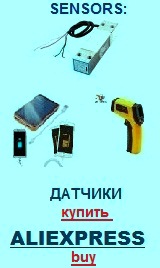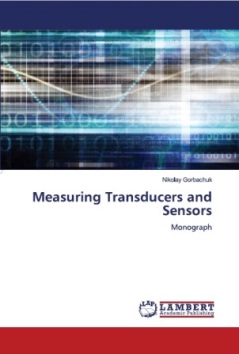Transducers, gauges, sensors - Information portal © 2011 - 2023 Use of material is possible by placing an active link
Temperature measurement using thermocouples made at home
In this article we discuss the measurement of temperature using thermocouples made with their own hands, but provides information useful for understanding the operation of the thermocouples manufactured by industry standard.
If the desired temperature measurement accuracy at 0.5 K (may be higher, the error depends on the capabilities of the measuring device V), it is necessary to produce and to use a differential thermocouple (see Fig.1A). m1, m2 - metal.
Calibrating of thermocouple (calibration charts)
For a condition, when a free end(shut) of thermocouple is at the zero of degrees celsius. A temperature is driven to °C, E.M.F. (tension) in mV.
chromel - alumel (-270 °с to 1370 °с)
(0 °с to 1820 °с)
chromel - constantan (-260 °с to 1000 °с)
copper - constantan (-270 °с to 400 °с)
chromel - kopel (-20 to 200 °с)
русский / english
Home >> Temperature, thermoelectricity. Thermocouple >> Temperature measurement using thermocouples
• Information about various converters and sensors of physical quantities, parameters of various physical processes is presented.
• Electrophysical properties and effects in various electrical materials.
• Theory, experimental results, practical application


Fig.1
How to make a thermocouple (weld the thermocouple) displayed on the page - Manufacturer of the thermocouple.
To measure the temperature in the climate range (room temperature) are best suitable thermocouple chromel-Kopel, the main advantage of which is high sensitivity in the range of room temperature.
For measurements in the low temperature region it is possible to use a thermocouple chromel - alumel, copper - Constantan, etc. (see calibration table).
For high temperature using thermocouples based on platinum thermocouple chromel-alumel, etc.
Calibration table for thermocouples is composed of conditions, when one of the junctions of the differential thermocouple is at 0 °C. in order to use such a condition in practice, one of the junctions of the thermocouple is immersed in the container (thermos) with melting ice, the temperature of which, as we know 0 °C.
Diagram of the temperature measurement object O a differential thermocouple is shown in Fig.1b.
For example, consider that measurements are taken using a thermocouple chromel-Copel. The temperature of the object is determined by reading voltmeter (galvanometer) V. for Example, we know that the object is at a temperature above 0 °C, the voltmeter U = 6,43 mV. Look at the table and determined that a thermoelectric power corresponds to a temperature of 93 °C. it Should be borne in mind that the sign of the thermopower depends on the polarity of the thermocouple to the meter V and the transition temperature above 0 °C will change to the opposite.

Fig.2
If technical conditions are satisfied with the measurement accuracy to the level of a few degrees, it is possible to use a thermocouple with one junction (see Fig.2). If we analyze physical processes in such a measuring scheme, we can see that in this case the role of the temperature (the second junction) on which is formed the thermopower, plays room temperature (the temperature at which are the terminals of the measuring device of the voltmeter). Accordingly, it is accounted for when using the calibration tables and the determination of the object temperature. The thermoelectric power U, which, using the table, determine the temperature of an object will be equal to:
U = Uk + Uv,
where Uk is the tabulated value of the EMF differential (two seals) of the thermocouple at room temperature tk (the temperature of the device - for example, tk = 24 °C, in this case Uk = 1,57 mV), Uv is the measured thermoelectric power (readings of the voltmeter V).
We took for example the room temperature of 24 °C (Uk = 1,57 mV) if the voltmeter readings of 3.05 mV, respectively, then U = 4,62 mV and using the table determined that the object temperature O - 68 °C.
For ease of calculation, and determining the temperature using a thermocouple with one junction possible dependence of the EMF of the thermocouple to the temperature to be approximated by a linear dependence. In this case, the temperature of the object to be determined:
to = tk + Uv/j,
where j = ΔU/Δt is the average temperature sensitivity of the thermocouple in a certain range of temperatures.
For example, chromel-Kobeleva the thermocouple in the temperature region (0 - 200) °C an average sensitivity of j is approximately equal to 0.074 mV/°C.
See also:
CONVERTERS, GAUGES, SENSORS
Information, news, advertising


